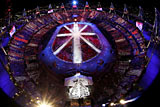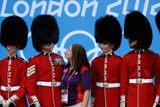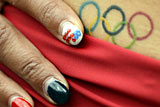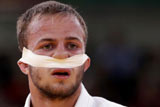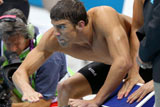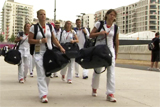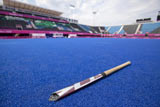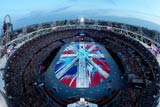Diving
Updated: 2012-05-14 16:42:50
( london2012.com)
|
|||||||||||
Diving requires acrobatic excellence and supreme coordination skills, as athletes dive from heights of up to 10m into the waters below. Competitive Diving developed from gymnastics in the 18th century, when gymnasts in Sweden and Germany began to perform tumbling routines into water.
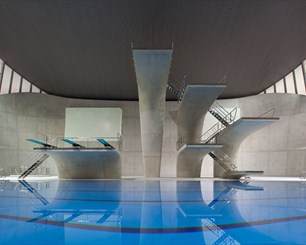 |
Competition dates
July 29 - Aug 11
Venue
Olympic Park - Aquatics Center
Number of events
There are four men's and four women's events: 3m Springboard, 10m Platform, Synchronised 3m Springboard and Synchronised 10m Platform.
Number of competitors
136 (68 men and 68 women). Each country is limited to two athletes in each individual event and one team (two athletes) in each Synchronised event.
Field of play
The diving pool is 25m long and 5m deep. The eight Diving events feature either a springboard, 3m above the pool, or a fixed platform, set at a height of 10m. Springboards must be at least 4.8m long and 50cm wide, while platforms should be at least 6m long and 3m wide.
History of Diving at the Olympic Games
Diving made its Olympic debut in 1904, where medals were awarded for men in the 10m Platform and the Plunge for Distance (a Diving long jump event, which never again appeared on the Olympic programme). Women's Diving was introduced in 1912 and Synchronised Diving made its first Olympic appearance at Sydney in 2000.
The basics
Divers submit in advance the dives which they will perform. The more difficult a dive, the higher the potential score if it is executed correctly: judges award a score out of 10 for each dive, which is multiplied by the dive's degree of difficulty. In the Synchronised Diving events, pairs of athletes dive in tandem and are assessed for their execution and synchronisation by separate groups of judges - a judge never assesses both execution and synchronisation. The higher the judges' score, the higher the diver/team is placed.
Officials
Judges (seven for the individual events and 11 for the Synchronised) assess all phases of the dive, including the level of synchronisation. Each judge awards a score out of 10.
Keys to success
Dives are divided into four stages - the starting position, the take-off, the dive itself and the entry into the water. Each of these is judged against a strict set of criteria and the winning divers perform difficult and ambitious dives where every part is as near to perfection as possible. Divers aim to enter the water vertically with as little splash as possible. If you see a diver make no splash at all, you can expect very high marks. In the Synchronised events, the two divers must dive in perfect harmony with each other.
Breaking the rules
Divers may score zero on a dive for double-bouncing on the end of the board, performing a dive other than the one they stated or taking too long to dive. Divers also have marks taken off for restarting a dive or armstand.
Jargon buster
Armstand - a platform dive that begins from the hands.
Platform - a fixed diving board, at least 6m long and 3m wide. In Olympic competition, it's 10m above the water.
Pike - a diving position for which the diver bends the body at the hips, keeping the legs straight.
Springboard - a flexible diving board, at least 4.8m long and 50cm wide.
Tuck - a diving position in which the diver curls up into a ball, holding the shins towards the body.
Medal Count |
||||
| 1 | 46 | 29 | 29 | |
| 2 | 38 | 27 | 22 | |
| 3 | 29 | 17 | 19 | |
| 4 | 24 | 25 | 33 | |
| 5 | 13 | 8 | 7 | |
| 6 | 11 | 19 | 14 | |

